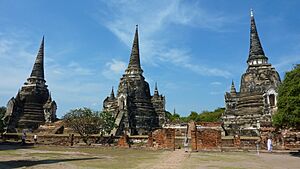Monarchy of Thailand facts for kids
Quick facts for kids King of Thailand |
|
|---|---|
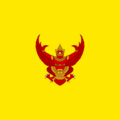
Royal Standard
|
|
| Incumbent | |
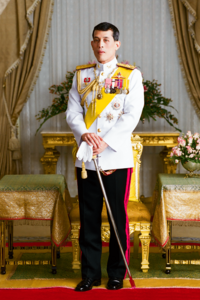 |
|
| Vajiralongkorn since 13 October 2016 |
|
| Details | |
| Style | His Majesty |
| Heir presumptive | Dipangkorn Rasmijoti |
| First monarch | Si Inthrathit |
| Formation | 1238 |
| Residence |
|
The monarchy of Thailand is how Thailand is governed, with a constitutional monarchy. This means the country has a king, but his powers are set by a constitution. The king of Thailand (Thai: พระมหากษัตริย์ไทย) is the head of state and leads the Chakri dynasty, which is the current royal family.
The Chakri dynasty started in 1782. However, the idea of having a king in Thailand goes back to the Sukhothai Kingdom in 1238. There was a short time without a king after Ekkathat died, until Taksin became king in the 18th century. In 1932, Thailand changed from having an absolute king to a constitutional monarchy. This happened after a peaceful event called the Siamese Revolution of 1932. The king's official home for ceremonies is the Grand Palace in Bangkok. His private home is the Dusit Palace. The king of Thailand is the head of the country, the top commander of the Royal Thai Armed Forces, and a supporter of Buddhism and other religions.
Contents
History of Thai Kingship
Early Beginnings
Thai kingship has a long history, going back over 800 years. The first king of a united Thailand was Si Inthrathit, who started the Sukhothai Kingdom in 1238. Early ideas about kingship came from two main beliefs: Hinduism and Theravada Buddhist teachings.
One idea was based on the ancient Indian Kshatriya (Thai: กษัตริย์), meaning a warrior-ruler. This meant the king's power came from his military strength. The second idea was from Buddhism, called Dhammaraja (Thai: ธรรมราชา). This idea, which came to Thailand around the 6th century AD, meant the king should rule fairly and follow the teachings of the Buddha.
In 1279, King Ram Khamhaeng changed things. He introduced a new idea called "paternal rule" (Thai: พ่อปกครองลูก). This meant the king would rule his people like a father takes care of his children. This is why he was known as Pho Khun Ram Khamhaeng, meaning 'Father Ruler Ram Khamhaeng'. This idea didn't last long. By the end of the Sukhothai Kingdom, the older ideas of kingship returned.
Kings of Ayutthaya

The Ayutthaya Kingdom took over from Sukhothai in 1351, founded by King Ramathibodhi I. During this time, the idea of kingship changed again. Influenced by ancient Khmer traditions, the Hindu idea of a "divine king" became important. The king was seen as a reincarnation of Hindu gods like Indra, Shiva, Vishnu, or Rama. Many kings used "Ramathibodhi" in their titles. Buddhist influence was still there, and kings were also called "Dhammaraja," meaning a king who rules by Buddhist principles.
A new concept, "Devaraja" (Thai: เทวราชา), or "divine king," became very strong. This idea came from the Khmer Empire and suggested the king was an incarnation of the god Vishnu and a Bodhisattva (an enlightened being). This meant his power came from his religious importance, good morals, and royal bloodline.
The king was seen as a semi-divine figure, someone to be worshipped and respected. The monarchy became very separate from the common people, ruling with absolute power. Kings lived in grand palaces, imagining themselves as a "Chakravartin," a powerful ruler of the world. They used grand ceremonies to show their power. For four centuries, these kings led Ayutthaya through times of great cultural, economic, and military growth.
Royal Customs and Rules
The Kings of Ayutthaya created special systems to help them rule. King Trailokanat in the 15th century set up sakdina. This was a social system that ranked people based on their importance and how much land they were allowed to control.
Rachasap is a special vocabulary used only when talking to or about the king and other royal family members. It's a way to show respect.
King's Authority
The king was the main leader, making laws, and acting as the chief judge. All laws and decisions were thought to come from him. Titles like "Lord of the Land" (พระเจ้าแผ่นดิน Phra Chao Phaen Din) and "Lord of Life" (เจ้าชีวิต Chao Chiwit) showed his great power. Foreign visitors often thought the king was an absolute monarch, like in Europe. However, in Thai tradition, the king's duties were based on ancient Indian ideas, focusing on his responsibility to rule fairly and follow Dhamma. This system was interrupted in 1767 when a Burmese army attacked and burned Ayutthaya.
Restoring the Kingdom
After a short civil war, Taksin brought the country back together, starting the Thonburi Kingdom. King Taksin changed the way kingship was seen. He didn't hide behind a mystical image like many Ayutthayan kings. Instead, he often met with common people and took part in public events. He also focused on building defenses for his new capital, Thonburi.
Chakri Kings
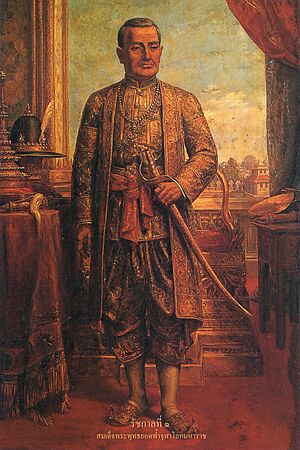
In 1782, Phutthayotfa Chulalok (Rama I) became king. He moved the capital to the Bangkok side of the Chao Phraya River. There, he started the House of Chakri, which is Thailand's current ruling family. He also created the position of Supreme Patriarch to lead the Buddhist monks.
During the Rattanakosin period, the Chakri kings tried to bring back some of the Ayutthayan ideas of kingship, focusing on the connection between the king and his people. However, they still kept all the power for the throne. Kings Phutthaloetla Naphalai (Rama II) and Nangklao (Rama III) started to create a more modern government by setting up a supreme council to help manage the country.
Mongkut (Rama IV) made a big change. Before becoming king, he spent 27 years as a Buddhist monk and learned English. As king, he continued to appoint officials to his supreme council. He also started to reform the monarchy to be more like Western "enlightened rulers."
Chulalongkorn (Rama V) became king in 1868 when he was 15. He had learned about Western ways from his teacher, Anna Leonowens. He wanted to modernize the monarchy. He traveled a lot to see how Western governments worked. He stopped the practice of prostration, where people had to lie down in front of the king. He also changed many laws about how the king and his people interacted, but kept many old traditions. In 1874, he created a privy council, similar to European councils, to help him rule. During his reign, Siam (Thailand's old name) managed to avoid becoming a colony of Western powers. In 1905, he ended slavery in Thailand.
His son, Vajiravudh (Rama VI), became king in 1910. He continued his father's efforts to modernize the monarchy. He also updated the laws about martial law to be more in line with modern rules.
Prajadhipok (Rama VII) became king in 1925. He had studied in England. He created a council, like a cabinet, where important government officials could meet to make decisions. This council, called the Supreme Council of State of Siam, existed until 1932.
Constitutional Monarchy
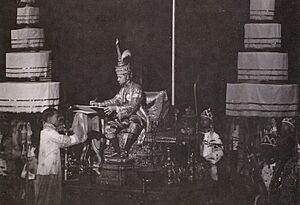
In June 1932, a group of students and military officers, called "the promoters," carried out a peaceful revolution. They took power and asked King Prajadhipok to give the people a constitution. The king agreed, and in December 1932, Thailand received a constitution. This ended 150 years of absolute rule by the Chakri kings. From then on, the king's role became more symbolic. His powers were then used by a prime minister and the national assembly.
In 1935, Prajadhipok (Rama VII) gave up his throne because of disagreements with the government. He lived in the United Kingdom until he passed away in 1941. His young nephew, Ananda Mahidol (Rama VIII), became the new king at 10 years old. He was living in Switzerland, so a group of regents was appointed to rule for him. During this time, the king's powers were largely taken over by the government of Plaek Phibunsongkhram, who changed the country's name from Siam to Thailand.
After King Rama VIII's sudden death in 1946, Prince Bhumibol Adulyadej (Rama IX), who was 19, became the new monarch. King Bhumibol was one of the world's longest-reigning monarchs. He passed away on October 13, 2016, at the age of 88.
The Monarchy Today
In the 21st century, the role of the Thai monarchy is often discussed. There are laws in Thailand that protect the monarchy from criticism. These laws are meant to uphold the respect and honor of the royal institution.
The king is helped in his duties by his Private Secretary and the Privy Council of Thailand. They also work with the Prime Minister. The king no longer creates all the laws; that is now done by the National Assembly of Thailand. However, all new laws passed by the assembly need the king's approval to become official. The royal household and its money are managed by the Bureau of the Royal Household and the Crown Property Bureau. These groups are not part of the government, and the king appoints their staff.
The government works to promote respect for the monarchy. This includes campaigns that educate people about the king's contributions to the country.
Timeline of Monarchs
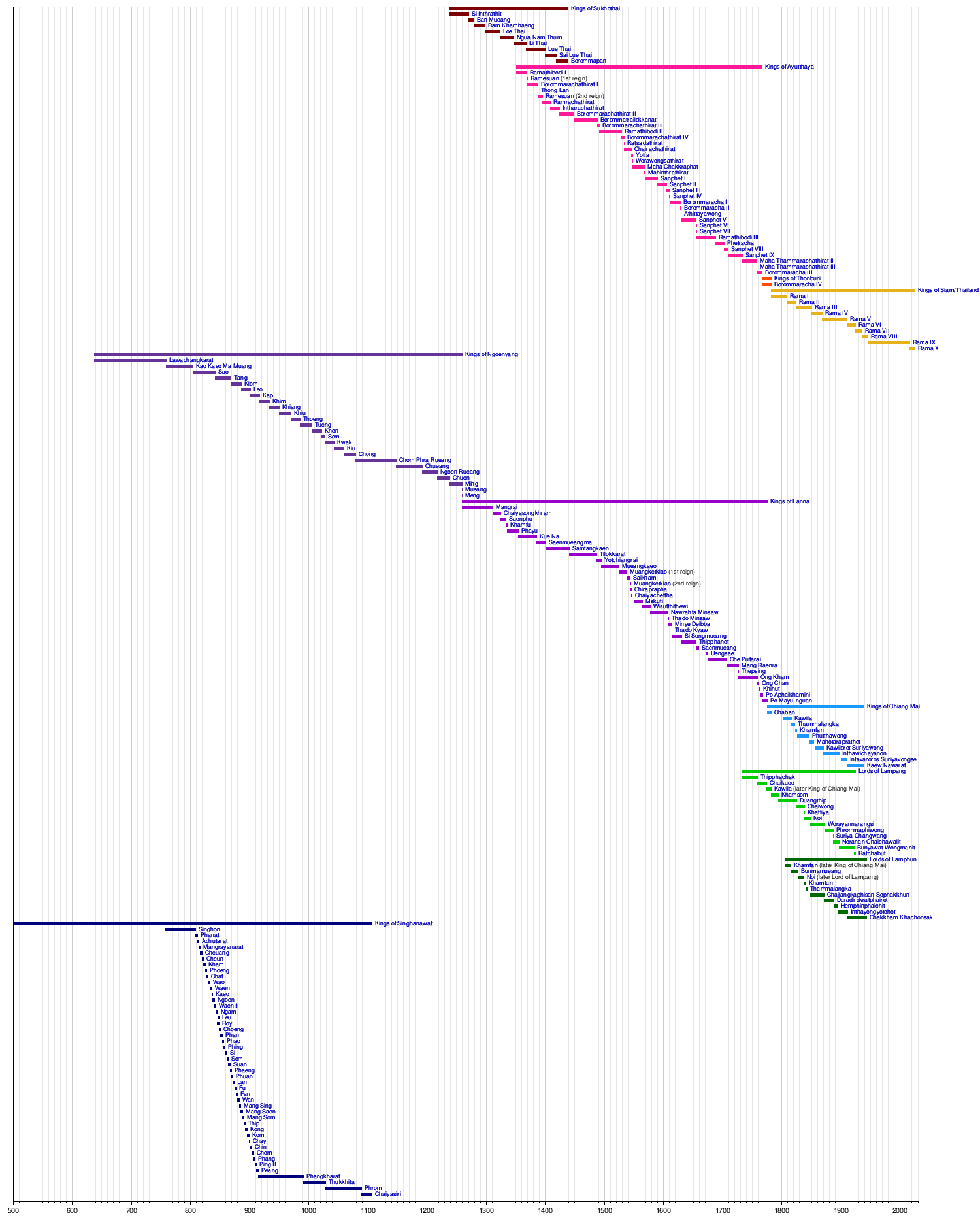
*Including regional kingdoms and polity
Royal Regalia and Symbols
Royal Regalia
The special items used by the Thai king, called royal regalia of Thailand (Khrueang Raja Kakudhabhand, Thai: เครื่องราชกกุธภัณฑ์), were mostly made during the reigns of King Rama I and Rama IV. The original items were lost when Ayutthaya was attacked in 1767. These regalia are mainly used during the king's coronation ceremony. You can see them on display in the Museum of the Grand Palace in Bangkok.
The five most important items are:
- Royal Nine-Tiered Umbrella (Phra Maha Swetachatra; พระมหาเศวตฉัตร) - This is the most important item. There are seven of these umbrellas at different palaces.
- Great Crown of Victory (Phra Maha Phijay Mongkut; พระมหาพิชัยมงกุฎ) - The king's official crown.
- Sword of Victory (Phra Saengkharga Jay Sri; พระแสงขรรค์ชัยศรี) - Found in 1784, this sword represents the king's military power.
- Royal Staff (Dharn Phra Korn; ธารพระกร) - A symbol of justice.
- Royal Fan and Flywhisk (Walawijani; วาลวีชนี) - A golden fan and a flywhisk made from the tail of a white elephant.
- Royal Slippers (Chalong Phra Bada; ฉลองพระบาท) - Official golden shoes.
There are also royal utensils (Phra Khattiya Rajuprapoke; พระขัตติยราชูปโภค) for the king's personal use. These include a Betel nut set, a water urn, a vessel for pouring liquids, and a receptacle. These special objects are always placed next to the king's throne during royal ceremonies.
Other Symbols of Kingship
- Royal White Elephant - Often one represents each king's reign.
- Royal Garuda - The official symbol of the king and Thailand.
- Royal Standard of Thailand - The king's official flag.
- Royal Flags - Personal flags for the king and royal family.
- Sansoen Phra Barami - The royal anthem.
- Traditional Band of the Royal Family of Thailand - A marching band that plays traditional Thai music for royal events.
Royal Ceremonies
The king and his family take part in many royal ceremonies each year. Some of these traditions are very old, dating back to the 13th century.
- Royal Coronation Ceremony - When a new king officially takes the throne.
- Royal Barge Procession - A grand parade of royal barges on the river.
- The Changing of the Robes of the Emerald Buddha - A special ceremony for the famous Emerald Buddha statue.
- Trooping the Colours and Armed Forces Pledge of Loyalty - A military parade where soldiers show their loyalty.
- Military Colours Consecration and Pledge Taking Ceremony - Another military ceremony.
- Oath of Allegiance Ceremony - Where people promise loyalty to the king.
- Speech from the Throne to the National Assembly of Thailand - The king gives a speech to the country's lawmakers.
- Royal Funeral Ceremony - A special ceremony when a member of the royal family passes away.
Royal Orders and Decorations
The king is in charge of giving out many special awards and honors, called Royal Orders and Decorations. He decides who receives these awards, though sometimes the government suggests people. There are twelve main Royal Orders, and some of them have different levels. These awards are given to people who have done great service for Thailand or to foreign leaders.
See also
 In Spanish: Rey de Tailandia para niños
In Spanish: Rey de Tailandia para niños


